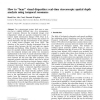2620 search results - page 450 / 524 » An Evaluation Technique for Binarization Algorithms |
BIOINFORMATICS
2006
13 years 9 months ago
2006
Motivation: Most previous approaches to model biochemical networks havefocusedeither on the characterization of a networkstructurewith a number of components or on the estimation ...
BMCBI
2004
13 years 9 months ago
2004
Background: In a previous paper, we introduced MUSCLE, a new program for creating multiple alignments of protein sequences, giving a brief summary of the algorithm and showing MUS...
BC
1998
13 years 8 months ago
1998
Abstract. In a stereoscopic system, both eyes or cameras have a slightly dierent view. As a consequence, small variations between the projected images exist (`disparities') ...
ICPPW
2009
IEEE
13 years 6 months ago
2009
IEEE
Identifying peptides, which are short polymeric chains of amino acid residues in a protein sequence, is of fundamental importance in systems biology research. The most popular appr...
SDM
2011
SIAM
12 years 12 months ago
2011
SIAM
A binary matrix is fully nested if its columns form a chain of subsets; that is, any two columns are ordered by the subset relation, where we view each column as a subset of the r...

